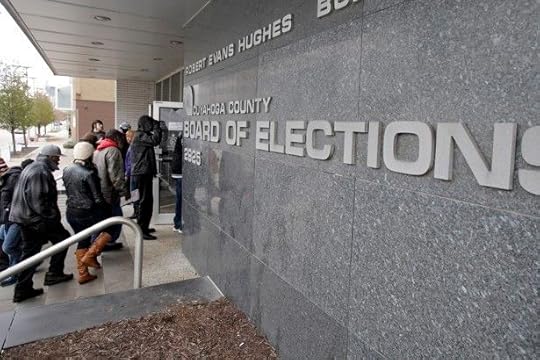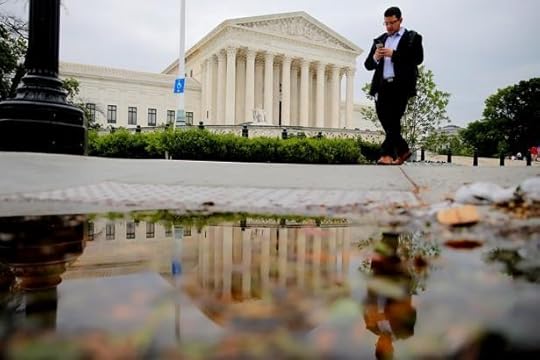Atlantic Monthly Contributors's Blog, page 147
June 8, 2016
Fraud Charges for a New York City Union Boss

Federal agents arrested Norman Seabrook, the domineering president of New York City’s correctional-officers union for more than two decades, on federal fraud charges Wednesday.
In a 17-page criminal complaint, prosecutors allege Seabrook invested $20 million from the New York City Correction Officers’ Benevolent Association’s pension fund in Platinum Partners, a Manhattan hedge fund run by Murray Huberfeld. As a kickback for the investment, Huberfeld allegedly gave Seabrook a Ferregamo bag containing $60,000 in cash through an intermediary. Huberfeld was also arrested Wednesday.
“Norman Seabrook, as COBA’s president for over two decades, allegedly made decisions about how to invest the nest egg for thousands of hard-working public servants, based not on what was good for them, but on what was good for Norman Seabrook,” said Preet Bharara, the U.S. Attorney for the Southern District of New York, when announcing the charges at a Wednesday press conference.
During his 21-year tenure as union president, Seabrook wielded tremendous influence in local and state politics. A December 2014 profile by The New York Times described him as a “roadblock to reform” at the troubled Riker’s Island jail.
Under his leadership, correction officers, long overlooked among the city’s uniformed services, have seen large gains in salary and pension benefits, reaching parity with firefighters and police officers. Like Mr. Seabrook, the overwhelming majority of his members are black. They have risen to dominate the top ranks of the department, making it far more diverse than the Police and Fire Departments, where most of the leadership is white.
But current and former city officials repeatedly described Mr. Seabrook as the biggest obstacle to efforts to curb brutality and malfeasance at Rikers. He has vigorously resisted stiffer penalties for the use of excessive force by guards and has fought stronger screening measures designed to stop correction officers from smuggling weapons and drugs into the jails. Time and again, Mr. Seabrook has shielded his members from serious punishment when investigators like [former city corrections chief investigator Florence] Finkle have tried to go after them.
Bharara’s office has earned a national reputation for doggedly pursuing public-corruption investigations in New York. In 2015, two separate investigations brought down New York State Assembly Speaker Sheldon Silver and State Senate Majority Leader Dean Skelos. The Times reported in April that a federal corruption probe was looking at “some aspects” of New York City Mayor Bill de Blasio’s campaign fundraising. That probe is linked to Seabrook’s prosecution, although officials have not elaborated on its connections.

Another Court Defeat for Ohio's Strict Voting Laws

For the second time in two weeks, a judge in Ohio has struck down provisions of the state’s voting laws. Federal district court Judge Algenon Marbley said two laws passed in 2014 violated the Voting Rights Act and the Constitution’s guarantee of equal protection with laws that made it too easy for provisional ballots to be thrown out for “trivial” errors.
Marbley ruled that the laws could have a racially disparate effect, whether or not that was the intent:
Make no mistake: the court is deeply troubled by the flurry of voting-related legislation introduced during the time period in question, all of which sought to limit the precious right to the franchise in some manner, and most of which was a peripatetic solution in search of a problem. The court agrees, moreover, that the Republican-controlled General Assembly’s frenetic pace of introducing such legislation reflects questionable motives, given the wealth of other problems facing the state which actually needed solutions. If the dog whistles in the General Assembly continue to get louder, courts considering future challenges to voting restrictions in Ohio may very well find that intentional discrimination is afoot.
Secretary of State Jon Husted, a Republican, criticized the decision as the “latest attempt at judicial activism.”
Restrictions on voting, of which many of have been passed in the United States over the last decade, tend to disproportionately affect minority voters, who overwhelmingly vote Democratic. The laws’ proponents, mostly Republicans, say the racial effects are not intended, and that the laws are needed to protect the sanctity of the vote.
Two weeks ago, a state court judge ruled that the elimination of “Golden Week,” a period in which Ohioans could both register to vote and cast a ballot, was illegal. This month, Reuters reported on how the Buckeye State is purging voters from rolls who have voted as recently as 2008.
While there have been recent high profile battles over voting rights across the country, from North Carolina to Wisconsin to Missouri, Ohio is a particularly important battleground because it’s a perpetual swing state, often decided by close margins—the sort of margins that could be influenced by the elimination of thousands of Democratic votes.

Harry Potter and the Never-Ending Spoiler War

The year 2005 has come to feel like ancient times in the history of Internet fan culture. Back then, YouTube was new, few geeks needed to have opinions on “social justice,” and Tobey Maguire was still the face of the (lower-case) Marvel cinematic universe. Most bewilderingly, “spoiler warning” wasn’t a common term—in fact, the concept of mass spoiling was so novel as to become a pastime in itself.
That year saw the release of the sixth Harry Potter book, which contained the most shocking twist to date in J.K. Rowling’s ongoing saga of Muggles and magic. Online, images of the page revealing that twist went viral prior to publication. On the night of the book’s release, some trolls drove around to the Barnes & Noble shops where fans had lined up in costume and shouted—here’s my spoiler warning!—“Snape kills Dumbledore!” The wails of the suddenly sullied masses were recorded in videos uploaded, as such things were in those days, to eBaumsworld. Someone took out a billboard with the offending information, and The Onion later sent up the whole mess with the headline “Final Harry Potter Book Blasted For Containing Spoilers.”
This was a moment of savagery that society had to live through in order to get somewhere more civilized. There hasn’t been quite as mass a spoiling as “Snape Kills Dumbledore” since 2005, though there has been anguished debate over how exactly fans and critics should go about discussing, say, Game of Thrones book developments that have yet to air on TV. By now, a pretty sturdy—if imperfect—code of conduct has developed. If you’re going to talk about soon-to-air or recently aired (or published) twists, warn people beforehand. Don’t put surprising information in headlines. Start a separate thread. Basically: Show some courtesy to others.
Harry Potter, the most influential all-original storytelling phenomenon of the new millennium, continues to be on the vanguard of this etiquette evolution. Five years after the last Potter film and nine years after the last Potter book, Rowling’s saga is picking back up on stage in London with Harry Potter and the Cursed Child — Parts One and Two. Previews began Tuesday night, and Rowling, always an active social-media presence, has posted a video and tweets imploring viewers not to reveal any plot details online. She’s even coined hashtags: #KeepTheSecrets and #Don’tBeWormtail, a reference to a traitorous character.
Nevertheless, spoilers have indeed started to arrive online. They’re posted, for example, on a clearly marked Reddit thread, with specific details blacked out, requiring the reader to highlight over them to see them. Fan sites have begun dribbling out information about characters and settings—but, as far as I’ve seen, not much about the storyline itself. These articles have also been clearly marked. As with most other pop-culture happenings these days, Internet users will have a choice whether to click and find out more, or not.
This appears unacceptable to Rowling. Today, she posted a tweet labeling the publication Hypable as “Wormtaily.” Which, of course, probably sent more people to that site, where they’d find articles that had tortuously polite beginnings like this:
SPOILER ALERT FOR HARRY POTTER AND THE CURSED CHILD.
First thing’s first: Keep the secrets.
Just a few hours after the first performance, it’s already becoming apparent that Cursed Child spoilers are unavoidable. We understand some fans want to know a bit about what happened (hence this article, which reveals a minor plot twist), but we urge you to keep your discussions to closed groups. Lots of Harry Potter fans want to find this stuff out on their own.
That said: Several Hypable staffers attended the first preview performance of Harry Potter and the Cursed Child, Part 1 on Thursday night in London. It’s really unfair to share too many opinions before we’ve seen Part 2, but what we can do is give a few teasers of how the world looks 19-ish years later.
It’s an unusual moment. Cursed Child is an unprecedented work in that it’s advancing the plot of a very major fiction franchise—one whose plot has previously been advanced in mass-market novels—through the exclusivity of live theater (adding to the strangeness is the fact that it’s made up of two separate plays running in matinee and evening performances). The story itself will be available for all to learn on July 31, when the script will be published for purchase, a day after the play officially opens. Many fans will prefer to wait to read the material or see it live to find out what happens to Harry 19 years after the events of Deathly Hallows. Some will not.
That would seem to be their prerogative, but Rowling is trying to exert control over the reception of her work in a way that is unusual for most creators but typical for her (see the recent New York Times story about how she’s continued updating her universe both through tossed-off remarks and elaborate add ons, including a forthcoming movie). She believes that plot spoilers deprive viewers and readers of the full power of her work, and she’s right, to an extent. But the fact that she’s able to keep telling the Harry Potter tale to such wide interest, a decade after many readers were subjected to one of the most infamous spoilers of all time, highlights that there’s more to the magic of storytelling than surprise.

Will the Supreme Court Rule on Transgender Bathrooms Sooner Rather Than Later?

A carefully watched Virginia case involving transgender bathrooms might be headed to the Supreme Court. The case, which could have an important bearing on North Carolina’s transgender bathroom law and a brewing legal fight between the Obama administration and a handful of other states, concerns Gavin Grimm, a transgender student born as a woman. Grimm requested the right to use the boy’s restroom at school.
In April, a three-judge panel of the Fourth Circuit ruled that the Department of Education could consider gender identity covered by Title IX of the Civil Rights Act—in effect ruling that Grimm should be allowed to use the boy’s bathroom, though leaving it to a lower court to make the ruling. In May, the court declined a request from the local school board to hear the case en banc, with all of its judges sitting.
Now the school board has requested that the Supreme Court hear the case. The board also wants a stay on the circuit court’s ruling; for now, there’s a temporary stay. Four justices would have to vote to hear the case for the Court to take it up.
The Grimm case has been seen as essential to the battle over North Carolina’s HB2, which—among other things—requires transgender people to use bathrooms in public facilities that correspond to the sex on their birth certificate. The Department of Justice threatened to withdraw federal funding for schools, highways, and more to the state of North Carolina, and the state sued for a court ruling clarifying the law. Because North Carolina is in the Fourth Circuit, the Grimm case seemed to many observers to augur a favorable outcome for the federal government.
Since then, however, the Departments of Justice and Education have issued guidance to all states requiring them to allow transgender students to use restrooms corresponding to the gender with which they identify. Eleven states banded together to sue over that rule, meaning that the Supreme Court was likely to hear the matter eventually. But if the justices grant cert in the Grimm case, legal clarity could come sooner—or not, given the Court’s current 4-4 split.

The Space Between Mourning and Grief

The morning after my sister Lauren died was cold and quiet, a mid-March prairie dawn, lit by gray half-light. For several hours I tried to figure out how to get out of bed. The most routine tasks are extraordinarily difficult in the early days of grief—Lauren’s death had torn a hole in my universe, and I knew the moment I moved I would fall right through it. Meanwhile, across the city, a former classmate of Lauren’s learned of her death. I’m still not sure how—she hadn’t kept in touch with Lauren during the three years since they graduated high school. But bad news travels astonishingly fast. The classmate selected what is perhaps the only picture of the two of them together, and decided to post it on Lauren’s timeline. Beneath it, she wrote “RIP” and something about heaven gaining an angel.
This Facebook post is how many of Lauren’s close friends learned that she had died. We—her family—hadn’t yet been able to call people. The first post sparked a cascade of statuses and pictures, many from people who barely knew her. It was as though an online community felt the need to claim a stake in her death, through syrupy posts that profoundly misrepresented who she was and sanitized what had happened to her. Lauren was an intensely private person, not one to identify with her diagnosis—a rare form of neurological cancer. And she would have had little patience for the mawkish kind of tributes on social media that followed.
The way people mourn online has been the subject of much cultural comment recently, particularly in the wake of mass tragedies and high-profile celebrity deaths, such as those of David Bowie and Prince. Some argue that the likes of Facebook and Twitter have opened up public space for displays of grief that had been restricted to private spheres of secular culture. But rather than reconstructing an outlet for public grief, social media often reproduces the worst cultural failings surrounding death, namely platitudes that help those on the periphery of a tragedy rationalize what has happened, but obscure the uncomfortable, messy reality of loss.
Social media has increased the speed and ease of communication to an unprecedented degree, and yet sites like Facebook and Twitter are poorly suited to grief’s strangeness. By design, social media demands tidy conclusions, and dilutes tragedy so that it’s comprehensible even to those only distantly aware of what has happened. The majority of Facebook posts mourning Lauren’s death were full of “silver linings” comments that were so far removed from the horror of the reality that I found them isolating and offensive. Implicit in claims that Lauren was no longer suffering, or that “everything happens for a reason” are redemptive clauses—ones that have a silencing effect on those who find no value in their pain.
It makes sense that those who knew Lauren sought some kind of meaning in her death in an attempt to re-order a universe disrupted. My sister was a smart, kind, athletic business student and a social entrepreneur—and she had an incredibly rare form of brain cancer that ended up killing her. It’s naively assumed that good, healthy people deserve good, healthy lives. When they’re robbed of what cosmic justice is owed to them, the laws that many believe govern human lives become suddenly suspect, or are revealed as illusory.
So if the impulse to ascribe meaning to senseless tragedy can be misguided, it’s also deeply human. The notion that suffering brings meaning and growth is common to many religious traditions, and lies at the heart of countless great stories. Scholars of tragedy and horror fiction have long argued that people seek out symbolic encounters with death as a way to confront their own mortality, albeit from a safe distance. From this vantage point, suffering and death take on an aesthetic quality that’s all but invisible to those enduring grief.
Sites like Facebook and Twitter are poorly suited to grief’s strangeness.
In her 2003 book, Regarding the Pain of Others, Susan Sontag described how civilians respond to pictures of wartime dead, writing, “We truly can’t imagine what it is like.” Anyone who’s spent time under fire, she says, knows this intuitively. Those who’ve experienced the final weeks of a loved one’s life need no reminder of the loneliness of that time. The novelist Aleksandar Hemon compared the sense of separateness he felt when caring for his daughter, who was dying of a brain tumor, to living inside an aquarium. Those on the outside could see in, to a degree, but those inside the glass led a completely alien existence.
The cultural anthropologist Renato Rosaldo thoughtfully addressed the subject of accessing the experiences of others in his essay “Grief and a Headhunter’s Rage.” He reflects on the years he spent studying how the Ilongot people in the Northern Philippines coped with loss: via the now-defunct practice of cutting off human heads. Although he documented life in Ilongot communities for most of his career, it wasn’t until his wife Michelle Rosaldo (a celebrated anthropologist in her own right) died suddenly that Rosaldo finally understood the kind of pain, born out of traumatic grief, that could manifest as headhunting. He writes that before Michelle’s death, he equated grief with sadness, adding that “certainly no personal experience allowed me to imagine the powerful rage Illongots claimed to find in bereavement.”
Grief responses in the secular West can seem equally strange to the outsider—but they tend to take place behind closed doors, in the early hours after another sleepless night, or hidden away in the minds of bodies that appear, for the most part, to be doing well, considering. The inner world of a grieving person is essentially other.
Anyone who’s experienced the loss of a loved one understands that most people are profoundly uncomfortable addressing death in physical interactions with the bereaved, which is where social media can come in. In response to the online mourning of David Bowie, The Atlantic’s Megan Garber argued that social media has allowed people to express their sadness and support the bereaved—a welcome return to an earlier era where social norms to help people cope with death were well established. A growing number of researchers agree—the media psychologist Jocelyn DeGroot posits that social networks can help people make sense of death, and maintain a relationship with the deceased. However, there’s an important distinction between mourning, a behavior, and grief, an internal emotional experience. Social media may have opened space for public mourning, but etiquette for ensuring that outpouring supports the bereaved (or at the very least doesn’t make their situation more painful) has yet to develop.
Certainly, there are people who welcome social media as an effective medium for working through their grief—but nothing could be further from my own experience. The problem with trying to definitively evaluate tools for grief management is that the feeling itself is so poorly understood. Even Elisabeth Kübler-Ross, the champion of grief’s “five stages,” realized on her deathbed that it was futile to try and break up or categorize grief into distinct components. Perhaps more so than any other emotional response, grief reacts with individual personalities in alchemical ways.
Social media may have opened space for public mourning, but etiquette for ensuring that outpouring supports the bereaved has yet to develop.
As for me, I have gained nothing through Lauren’s death, and she gained nothing from four years of arduous treatment. We have only lost. She lost her life, and I lost the person I love most in the world. And she didn’t “pass away,” as her online eulogizers wrote. She died choking on fluid that could no longer be cleared from her lungs because of a tumor pressing on her midbrain. And she died loudly, in my arms, as I tried to help her breathe. In spite of the grace with which she coped, her struggle was not an enriching experience for her; it made life more difficult. I am not stronger because of this experience; I am weaker, my life emptier than it was with her in it.
In light of grief’s complexity, it’s easy to see the appeal of platitudes. But because these narratives are so palatable, they become not only the dominant narratives of tragedy, but also, seemingly, the only acceptable ones. When I requested the removal of some of the most offensive posts, I was met not with understanding, but hostility. “My intention was to celebrate Lauren,” one wrote, defensively, as if good intentions were all that mattered. At my most cynical, I wondered if posts about other people’s deaths are used no differently than other content on social media—as a means of identity assertion in a busy online environment. It seemed that space had been created for certain interpretations of Lauren’s death, but it was a space inaccessible to me. There are some things that cannot be represented without cheapening the message; I think loss like this is one of them.
To be clear, I am not trying to tell anyone how to grieve. But rather than defending the rise of a new space for public morning as unambiguously good, perhaps the online community is in even greater need of a critical discussion—about what it means to make room for your own sadness while being sensitive to those closest to a loss. My proposal is simple: Wait. If the deceased is not a close family member, do not take it upon yourself to announce their death online. Consider where you fall in the geography of a loss, and tailor your behavior in response to the lead of those at the center. Listen. Rather than assuming the bereaved are ready for (or comfortable with) Facebook or Twitter tributes, send a private message, or even better, pick up the phone and call.
If you don’t feel comfortable expressing your condolences to the deceased’s friends and family, perhaps it isn’t your place to publicly eulogize. The simple acknowledgement that you may not understand what it’s like to grieve is itself a powerful act of empathy. The really important kind of empathy—the only kind worth practicing—asks us to imagine ourselves into the lives of others, and also, critically, to imagine our limits.

The Fake Drunken Boat Ride to Syria

Updated on June 8 at 12:10 p.m. ET
When a story seems too good to be true, it often is: Lewis Ellis, a 25-year-old from Manchester, who said he and his friends who went dolphin-watching while drunk in Cyprus, but ended up in Syria, now says he made it all up.
We initially reported the prank, which we and other news organizations fell for, as the consequences of an all-night bender.
Our original post:
Three young British men working in Cyprus, still intoxicated from an all-night bender, decided to go dolphin-watching early Monday morning in the Mediterranean. Without their wits about them, and without a translator, they got on a boat and set off from the coastal town of Ayia Napa.
After nine hours at sea, “We ended up in some f**king place called Tartus or something and literally had no idea where this f**king place was,” Lewis Ellis, a 25-year-old from Manchester and one of the men on the journey, told news.com.au.
That place just so happens to be in Syria, just over an hour west of Homs, one of the hotspots of the civil war ravaging the country. It’s also the home to a Russian naval base. So, naturally, when they got to shore, they were greeted by Russian military personnel. As Lewis describes:
“They took us away and started questioning us; you know, who were we? What were we doing in Syria? When we explained what happened they realised how ridiculous it was and they thought it was f**king hilarious. They took photos of us, selfies. They were laughing their f**king heads off.
“We were dying for a f**king smoke but the naval base was no smoking so they let us go out onto the rocks outside and we took more pictures. When we got back inside they hooked us up with wi-fi and fed us some kind of stew.”
More than 24 hours after the set off from Cyprus, the Russians arranged for a boat to bring them back to Ayia Napa. They realized how ridiculous their adventure was. As Ellis said, “I mean we went to watch f**king dolphins and we ended up in f**king Syria.”
There is no word on whether Bradley Cooper, Zach Galifianakis, and Ed Helms will play them in an upcoming movie—or whether the monkey will make another appearance.

Maria Sharapova's Two-Year Suspension

The International Tennis Federation has banned five-time Grand Slam champion Maria Sharapova for two years for doping violations.
Sharapova failed a drug test in March for the 2016 Australian Open. At the time, she admitted to testing positive for meldonium, a banned performance-enhancing substance. In its decision, the ITF said:
The Independent Tribunal determined that (1) Ms. Sharapova should serve a period of ineligibility of two years; (2) due to her prompt admission of her violation, that period of ineligibility should be back-dated under Article 10.10.3(b) of the Programme to commence from 26 January 2016 (the date of sample collection) and so should end at midnight on 25 January 2018; and (3) her results at the 2016 Australian Open should be disqualified, with resulting forfeiture of the ranking points and prize money that she won at that event.
In a statement on Wednesday, Sharapova said she would appeal the suspension to the Court of Arbitration for Sport, arguing she did not purposely seek a performance-enhancing substance from her doctor. She continues:
While the tribunal concluded correctly that I did not intentionally violate the anti-doping rules, I cannot accept an unfairly harsh two-year suspension. The tribunal, whose members were selected by the ITF, agreed that I did not do anything intentionally wrong, yet they seek to keep me from playing tennis for two years.
Sharapova is an Olympic silver medalist, competing for Russia at the 2012 Summer Games in London. She has been been a top-ranked tennis player five times by the Women’s Tennis Association.

June 7, 2016
Republicans Struggle to Make Their Anti-Poverty Plan Heard

The unveiling on Tuesday morning of the House Republican plan to combat poverty—the first in a series of policy rollouts this month—went about as well as Speaker Paul Ryan probably expected.
There was the sober and serious House speaker, sans jacket and tie and with the sleeves on his crisp, white shirt rolled up, passionately making the case for conservative policies that would create opportunity for the poor and “help people move onward and upward” in society. Standing alongside him were seven other sober and serious Republican members who had crossed the Anacostia River in D.C. to praise the work of a drug rehab facility that helped men and women—mostly poor and African American—battle addiction and climb out of poverty. The center’s director, Bishop Shirley Holloway, hailed Ryan as “the listener of America.”
And then a bunch of reporters asked Ryan if Donald Trump was a racist.
So it goes for the nation’s highest-ranking Republican, who has made it his year’s mission to fashion a substantive policy agenda and offer it up as a election-year shield to his embattled flock. On Tuesday, that meant shouting proposals into a media wind tunnel.
In the main, Ryan’s challenge is Trump, whose penchant for creating distractions and dominating news coverage hasn’t diminished a bit in the year since he launched his presidential candidacy. Endorsing the presumptive nominee has proven risky for any Republican. But the speaker’s belated embrace last week ended up particularly ill-timed, coming just ahead of Trump’s race-baiting attacks on the judge deciding a lawsuit against his failed university. Ryan disavowed Trump’s remarks on Tuesday and said they represented “the textbook definition of a racist comment.” Ryan, though, stood by his endorsement, arguing Republicans had a better chance of seeing their agenda enacted with Trump as president than with Hillary Clinton.
“This is how you fight poverty. This is how you create opportunity. This is how you help people move onward and upward.”
Another part of Ryan’s problem, though, is the limits of the platform itself. It is neither ground-breaking nor specific enough to serve as a rallying document for Republican candidates. This is no Contract with America, which was built around a set of concrete promises and legislative proposals. Rather, the meat of the anti-poverty is a 35-page report from a task force Ryan created in January. It is more substantive than a list of talking points, certainly, but it stops well short of specific action items or a bill. The five forthcoming proposals, including ideas on health care, national security, the economy, and tax reform, figure to be structured in a similar way.
The report calls for tightening work requirements for welfare, food stamps, and housing assistance programs. “Our plan starts with work, not welfare: If you are capable, we will expect you to work or prepare for work,” a two-page summary says. Republicans are also pushing to send more authority to the states and change programs so that there success—and funding—is based on how many people they help lift out of poverty. The plan would tackle what the report calls “the welfare cliff,” in which recipients are discouraged from taking new or higher paying jobs because the salary would not compensate for the reduction of benefits they would see as a result. Other recommendations include more school choice in education, cutting back financial regulations under the Dodd-Frank law, and making it easier for small businesses to band together to offer 401K retirement plans.
“This is how you fight poverty. This is how you create opportunity. This is how you help people move onward and upward,” Ryan said. “We wanted to start with poverty because we think this sums up our case. We want to build a confident American where no one is stuck, where no one settles, and where everyone can rise.”
By and large, these are proposals that Republicans have made before, and in some cases tried to pass into law. The anti-poverty agenda also downplays or jettisons earlier Ryan proposals that drew more bipartisan support, including an expansion of the Earned Income Tax Credit. As Democrats were quick to point out, what’s new about the GOP platform is mostly the packaging, re-branded under the heading, “A Better Way,” and complete with a website and hash tag.
“Frankly, it’s a new spin on a bad deal.”
“Frankly, it’s a new spin on a bad deal,” said Representative Steny Hoyer of Maryland, the House minority whip. Democrats also challenged the central premise underlying the Republican agenda—that federal welfare programs were failing in their mission to reduce poverty. “It is a distortion, and he tries to fool people with it,” said Representative Rosa DeLauro of Connecticut, who appeared with Hoyer at a panel discussion held by the left-leaning Center for American Progress.
For Democrats, the threat of Ryan’s agenda lies in its sales pitch, which has discarded the 1980s talk of “welfare queens” for the more universal language of upward mobility and self-sufficiency. One conservative congressman quoted Robert F. Kennedy while he touted the GOP plan. And who would argue with more results-oriented policies, targeting federal dollars toward the most successful ideas, reducing red tape, and “tailoring benefits to people’s needs,” as the report promises? Yet to liberals, the rhetoric obscures a far harsher reality: Republicans are proposing to align anti-poverty programs with their vision of a smaller, leaner federal government, which means steep budget cuts that they fear go well beyond trimming the fat. “Paul Ryan's anti-poverty proposals sound great, but they're fundamentally fraudulent covers for draconian budget cuts that will hike poverty,” tweeted Joel Berg, who runs the New York-based non-profit Hunger Free America.
Hoyer also needled Republicans for putting out a plan that they have no intention of voting on this year. “Speaker Ryan has rhetoric. There will be no agenda,” Hoyer said. “I predict to you there will be no bills on the floor of the House of Representatives in the next three to four months that will implement the suggestions in whatever document he puts forward.”
It’s a fairly safe prediction. Ryan has said all along that there would be little point in actually advancing the party’s agenda through the House until there is a Republican president who might sign it into law. And that brings us back to Trump. Explaining his decision to stick by a candidate he had just accused of racism, Ryan said that at least Trump might help Republicans enact their agenda, while Clinton assuredly would not. “Do I believe that Hillary Clinton is going to be the answer to solving these problems? I do not,” he said. “I believe we have more common ground on the policy issues of the day and we have more likelihood of getting our policies enacted with him than we do with her.”
Trump, of course, hasn’t committed himself to Ryan’s agenda, despite what the speaker called “an exhaustive discussion” of policy in the run-up to his endorsement. “He wants to take people out of poverty. So do I. And we`re going to come up with a plan,” Trump said Sunday on CBS’s Face the Nation. Pressed on the specifics, he said only there would be “a compromise” if he becomes president. That’s not much for Ryan to hang his hopes on. But he will forge ahead with the rest of the House Republican agenda, knowing that even if Trump’s antics drown out all substance now, it can provide a toehold this fall for Republican candidates looking to talk about something other than their party’s presidential nominee. As for the agenda’s viability under a President Trump in 2017? It seems Ryan decided that ‘maybe’ was the best answer he could get.

The Legacy of Helen Chavez

Helen Chavez, the widow of Cesar Chavez, and who picketed alongside her husband in the farm labor movement in the United States, got arrested in strikes, and raised the couple’s eight children, died Monday night. She was 88.
Chavez died of natural causes at a hospital in Bakersfield, California, surrounded by her family, according to a statement from her family.
Helen was notoriously shy of the media. She gave few interviews, and preferred to work in the background of the farmworker’s union movement that rose to prominence in the 1960s and 1970s. Her husband helped found and lead the United Farm Workers of America, a union of mostly poor Mexican and Filipino immigrants who worked in the fields of the West and Southwest. Farmworkers often earned little pay and worked in brutal conditions. Under Chavez’s direction and through organized strikes in the Southwest, wages and conditions improved.
A statement from the Chavez family released Tuesday said Cesar Chavez would not have led the farmworker’s labor movement if not for his wife’s support:
After they were married in 1948, Cesar Chavez would return home after experiencing a fresh injustice toiling in the fields and tell his bride, Helen, “somebody’s got to do something about it.” Helen Chavez nurtured her husband’s dream of organizing farm workers. She and their eight small children gave up a middle class lifestyle in 1962, embracing a life of voluntary poverty to support her husband’s labors. During the earliest years when he would sometimes return home to Delano, Calif. after days on the road feeling alone and demoralized, not having recruited anyone into his new union, she would encourage him, saying, “Cesar, you have to have faith in God that what you’re doing is right.”
...
During the Delano grape strike Helen joined vineyard picket lines before dawn and then worked all day running the Farm Workers Credit Union for more than 25 years before retiring. It loaned more than $20 million to farm worker members over the years. During this period she not only raised her own kids, but also became a surrogate mother to many young volunteers who came to Delano and later to La Paz, UFW headquarters in Keene, Calif., to work with the movement.
Cesar Chavez died in 1993, and for much of the future Helen remained out of public eye. A year after her husband died, Helen accepted on his behalf the Medal of Freedom, the highest American honor for civilians, from then-President Bill Clinton. In 2003, she gave a rare interview when the U.S. released a commemorative stamp featuring her husband. In 2012, at a dedication for a national monument to Cesar’s memory, she met President Barack Obama in Keene, her hometown where she helped organize farmworkers and where the Cesar Chavez Foundation is based.

D.C.'s Minimum-Wage Hike

Councilmembers in Washington, D.C., unanimously approved a $15 minimum wage on Tuesday. Mayor Muriel Bowser has pledged to sign the measure into law.
D.C. will join Los Angeles, New York City, and Seattle with similar minimum wage laws. The new measure would raise the minimum wage from $10.50 to $15 by 2020. Beyond that, the minimum wage would be tied to inflation.
The minimum wage for tipped workers, though, will not be as high. As The Washington Post reports:
But to assuage the District’s powerful restaurant-industry lobby, D.C. lawmakers have demanded that tipped workers’ pay rise by a smaller amount.
Tipped workers’ base rate would increase from $2.77 an hour to $5 an hour and would be tied to inflation. Employers in the District would also remain responsible for paying employees the difference between their base pay and minimum wage if tips do not make up the balance.
Advocates for the “Fight for $15” campaign have been pushing for a minimum wage increase in D.C. for over a year. Bowser proposed the measure in March.
Passing $15 minimum wage laws has growing momentum across the U.S. In April, California Governor Jerry Brown signed a law increasing the state’s minimum wage to $15 an hour, joining New York as the only states to pass a wage that high.

Atlantic Monthly Contributors's Blog
- Atlantic Monthly Contributors's profile
- 1 follower



